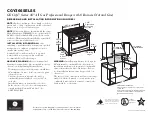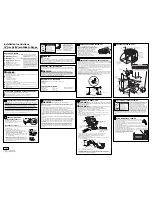
The regulator control "B" is below the indicator and can be turned
with the finger, the recommended position is "3".
The hardness of the water can be judged by incrustation or by the
level of dryness.
It is therefore important that the correct dosage of Rinse Aid is
regulated to give the best results.
After the wash,
. if streaks occur on the dishes, decrease the amount by one
position.
. if whitish spots occur, increase the amount by one position.
LOADING THE SALT
The dishwasher is fitted with a softener that clears the water of
lime which could cause scale and damage the dishwasher.
On the bottom of the diswasher there is a salt dispenser for
regenerating the softener.
The filter element of the softener unit should be recharged with a
salt specially produced for dishwashers. This salt can be bought
either as tablets or as granules.
To add salt, unscrew the cap of the
salt dispenser on the bottom and
refill the dispenser.
During this operation a little water
will overflow but keep adding salt
until the dispenser is fill, clean the
thread of salt residue and retighten
the
cap.
If the dishwasher is not required straightaway, set the
programme Cold rinse ("Eco+Rapid, 2 Leds") so that the salt
solution which has overflowed is discharged from the washing
tank.
The salt dispenser has a capacity of between 1.5 kg for efficient
use of the appliance, it should be refilled from time to time according
to the regulation of the water softener unit.
NB: it is necessary to add water until the dispenser overflows.
Only install the dishwasher completely filling the salt dispenser.
LOADING DISHES
It is essential to use a detergent that is specifically designed
for dishwashers either in powder, liquid or tablet form.
Unsuitable detergents, (like those for washing up by hand) do not
contain the proper ingredients for use in a dishwasher and impede
the efficient functioning.
Normal wash
The detergent dispenser is inside the door.
The dispenser lid should be closed before
every wash.To open it, simply press the
catch. At the end of each wash cycle the
lid is always open and ready for the next
time the dishwasher is used.
The amount of detergent to be used varies
according to how dirty the dishes are and
the type of wash. A 15g dose is normally
recommended. If the water is hard or the
dishes are exceptionally dirty, 25g of detergent should be
loaded. After pooring the detergent into the dispenser, close the
lid, since not all detergents are the same and the instructions on
the boxes of detergent can vary.
We should just like to remind users that too little detergent does
not clean the dishes properly whilst too much detergent not only
does not produce better results but is also a waste. Do not use
an excessive amout of detergent and help limit damage to the
environment at the same time.
Intensive washing
LOADING THE DETERGENT
FILLING THE RINSE AID DISPENSER
REGULATING THE RINSE AID (from 1 to 4)
.
The rinse aid dispenser "B" is to the right of the detergent dispenser
and has a capacity of about 130 ml.
Open the lid and pour in enough liquid, which
will last several washes. Try to avoid
overloading. Close the lid.
This additive, which is automatically released
during the last rinse cycle, helps the dishes to
dry quickly and prevents spots and stains
forming. It is always advisable
to use rinse aid.
Check the rinse aid level
through the indicator eye "A"
which is situated in the centre
of the dispensers.
FULL - Dark
EMPTY - Bright
USE
The basket has been carefully designed to make loading easy.
For good wash performance, remove any debris from the dishes
(bones, tooth picks, the remains of meat and vegetables) to avoid
blocking the filters, water outlet and washing arm nozzle and, as
a result, reducing washing efficiency.
Warning !
to avoid any injury from cutlery with blades or sharp
points, they can be placed with the handles upwards.
LOADING A 6 PLACES SETTING
(EN
50242)
A- 6 glasses
B- 6 dessert plates
C- 6 saucers
D- Small bowl
E- 6 tea or coffee cups
F - 6 flat plates
G- 6 deep plates
H- Medium bowl
I - Serving dish
L – Cutlery
LOADING 4 PLACE SETTINGS
PLUS
CASSEROLES
Casseroles, salad bowls, soup pans,
lids etc., can be loaded on the basket.
It is advisable to arrange the cutlery
in the basket provided for that
purpose. If there is any cutlery with
narrow handles, it should be placed
with handles upwards, to avoid falling
through the bottom of the basket and blocking the washing
arm. Do not put wooden handled lids in the basket, or any whose
lids are bonded with resin.
14 GB
.
7` )7
*
!
)*
A
B
Содержание TRIO 9501/1X
Страница 2: ......
Страница 3: ...SAFETY INSTRUCTIONS 03 GB WARNING 2 2 5 2 5 6 7 9 C D...
Страница 4: ...SAFETY INSTRUCTIONS 04 GB E H J K E J E M M M H M M H M M 5 M 5 M J E M O P...
Страница 66: ...IDENTIFICACI N DE PEQUE OS MENORES X 66 ES...
Страница 82: ...FEHLERSUCHE Kleine St rungen selbst beheben X _ v Q f v f v K f X 9...
Страница 98: ...STORINGLIJST _ ov v r orden r W v er v r 98 NL...
Страница 99: ......
Страница 100: ...W H GB D U ES H H NL D p D H FR T T 6 T V 5 DE D p U IT...















































